No one in the remodeling or custom home building world is unaware of the term Design/Build. But when you drill down to what specifically is connected to Design/Build (D/B), there is confusion. Some see D/B as a credential, or a process. Others see it as a marketing strategy.
When I was in architecture school during the 1970s, D/B was my thesis. I argued with professors that D/B would be the future and a viable way to do great work. I don’t claim to be an expert, but I have been thinking about the subject for many years. I did my first industry seminar on D/B in 1982 for a group of remodelers. Many of them said it was impossible to ask a homeowner for an upfront design fee or a deposit. Well, we all know the world has changed, and D/B has grown in awareness and practice.
I bring up history because not only has the homeowner changed, but many different D/B models also have emerged. For every 10 professional D/B businesses, there are eight different models. While I cannot go very deep into this subject in a short column, I can make you aware of some of the basic models.
1) One D/B category is a contracting business that offers design. This design can be in-house, with independent designers or architects. The motivation is to offer expanded services but most importantly control the process, which allows for better efficiencies, predictability, and profitability.
2) Another common model is the architect or designer who offers construction services. This model is motivated by profit and appeals to the client’s desire for one-stop shopping. These services can include construction management or hiring a small crew to build. The firm generally still does design work for a fee and also has a few projects that they handle from start to finish. The benefit of this model is consistency in quality, production acumen, and it is a business differentiator.
3) The pure D/B firm is truly an integrated process, sort of like a football team’s offense and defense. Both are equally important to the success of the project and client experience. This model will have both design and construction competence in-house. Architectural or professional design credentials are important along with the professional craft and production knowledge. Generally this firm is not interested in design only or construction only. So this type of D/B firm will not bid on someone else’s plans even though the construction team has the ability to build it. Conversely, the firm will not design for other contractors to have someone else build their work. While there are many variations, design fees are structured to motivate the client into continuing with the construction contract.
While there are as many differences as similarities between models, there are a few tips I can share.
1) Know who you are and follow what you do best.
2) Write down your processes in detail from A to Z. By doing so, you will discover flaws and opportunities for improvement.
3) Follow a consistent process 100 percent of the time.
4) Stick with your ideal project size and client demographics.
5) Make sure everyone working with you is aligned and singing the same page of music.
Design/Build is here to stay. While we may have many different dialects and processes, it can provide a client with a great product, a business with predictable growth, and can help home building’s reputation.
About the Author
Mark Richardson, Contributing Editor
Sign up for Custom Builder Newsletters
Get the latest news and updates.
